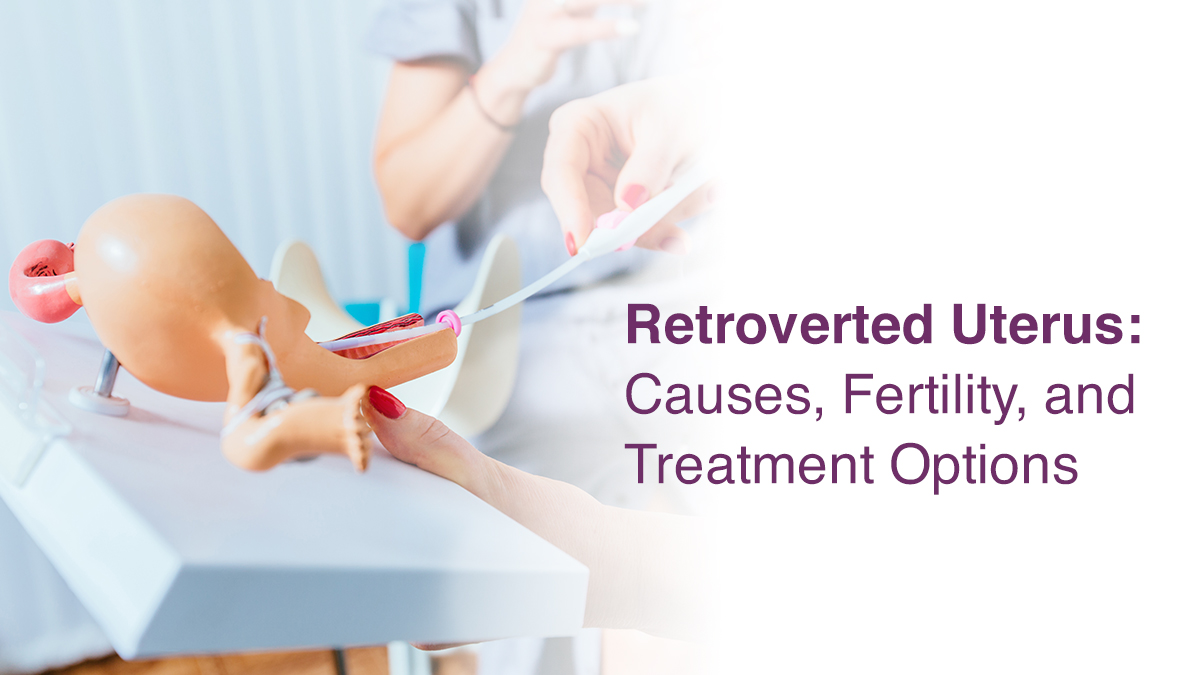A hollow, pear-shaped organ found in the pelvis, the uterus is an essential part of the female reproductive system. It is important for menstruation, pregnancy, and delivery because it creates a supportive environment for the growth of the fetus. Although the uterus normally tilts slightly forward (anteverted), this is not always the case. A retroverted uterus, in which the organ tilts rearward towards the spine, is one such variety. A retroverted uterus is generally benign. However, it can occasionally result in symptoms like lower back pain or discomfort during sexual activity. Recognising these differences emphasises the human body’s extraordinary adaptability and the necessity of personalised medical treatment.
What is a Retroverted Uterus?
When your uterus is tilted or turned backwards, it curves towards your spine rather than forward towards your abdomen. This condition is known as a retroverted uterus. It is also referred to as a titled uterus. During pregnancy, a baby grows inside your uterus. It rests between your bladder and rectum in your pelvis and has the shape of an upside-down pear. Its precise location in the pelvis varies from person to person and might alter, particularly during pregnancy.
Another name for a retroverted uterus is a tilted or tipped uterus. A retroverted uterus can develop later in life or be present from birth. Because they don’t exhibit any symptoms, some people are unaware that they have a retroverted uterus. Your healthcare professional may need to treat your symptoms in certain situations. This disorder is not a reason for concern and rarely results in health consequences.
Causes of a Retroverted Uterus
Many women are either born with a retroverted uterus or develop one as they mature. This is a common variety of pelvic anatomy. In actuality, the uterus is retroverted in around 25% of women. It might be genetics. In some cases, the underlying cause of the illness can be related to adhesions or scarring in the pelvis.
These consist of:
Endometriosis:
The uterus may become stuck in a backward posture, rather like glue, due to endometrial adhesions or scar tissue.
Fibroids:
The uterus may tilt backwards or become stuck because of uterine fibroids, PID, or pelvic inflammatory disorder.
Pelvic inflammatory disease (PID):
Untreated PID might result in scarring, which could function similarly to endometriosis.
History of Pelvic Surgery:
Scarring is another consequence of pelvic surgery.
History of Prior Pregnancy:
Sometimes, during pregnancy, the ligaments that hold the uterus in place stretch excessively and remain stretched. As a result, the uterus could tilt backwards.
Impact of a Retroverted Uterus on Fertility
Many people worry that their ability to conceive will be impacted by having a retroverted uterus. However, fertility is typically unaffected by the uterus’s location. If a patient is having trouble getting pregnant, doctors might take it into consideration, but only after ruling out other possible causes of infertility. A woman’s capacity to have a healthy pregnancy shouldn’t be impacted by having a retroverted uterus. In fact, the expanding uterus may tilt backwards during pregnancy. Usually, neither labour nor delivery are affected.
Symptoms of a Retroverted Uterus
Most of the time, a woman with a retroverted uterus is unaware that they have the issue because it doesn’t create any symptoms. Urinary tract infections (UTIs), lower back pain, and pain during sex are some of the side effects that have been recorded, despite the lack of identifiable symptoms.
Diagnosing a Retroverted Uterus
By performing a pelvic exam, your doctor can determine whether you have a retroverted uterus. During this examination, your doctor can feel where your uterus and cervix are to find out which way they tilt. An ultrasound can occasionally be used to confirm a retroverted uterus and screen out more problematic conditions like endometriosis or uterine fibroids.
Treatment Options for a Retroverted Uterus
The underlying causes of a tilted uterus can be addressed with a few different treatment approaches. These methods may be employed if a woman has significant symptoms that interfere with her life or ability to conceive.
Pessary:
It is a medical device that is inserted into the vagina by a physician. It can aid in repositioning the uterus and supports the uterus, vaginal walls, and other pelvic structures. A pessary is only a temporary solution because removing it will cause the uterus to return to its natural position.
Surgery:
The uterus may be repositioned for certain patients. An outpatient treatment called uterine suspension surgery can be performed with or without a mesh or sling. Lasting results and reduction in sex-related pain can be achieved through surgery.
Exercises:
By strengthening the muscles in the abdomen and pelvis, exercise can help reduce the discomfort that comes with having a tilted uterus. Kegel exercises, cat-cow stretches, and pelvic tilts all help to support uterine alignment and enhance posture. Gentle yoga stretches and bridge poses can improve flexibility and ease stress. Frequent practice may alleviate associated symptoms and support pelvic health in general. These are some of the exercises for retroverted uterus.
Fertility Treatments for Women with a Retroverted Uterus
Fertility is normally unaffected by a retroverted uterus. However, there are therapies available if difficulties in conception occur. In vitro fertilisation (IVF) and intrauterine insemination (IUI) are examples of assisted reproductive methods that can be beneficial. Adhesions and other underlying problems may be addressed with pelvic physical therapy. Fertility results may occasionally be improved by surgery to realign the uterus or treat diseases like endometriosis. Speaking with an expert guarantees a customised strategy.
When to Seek Medical Advice?
If a retroverted uterus results in ongoing symptoms like excruciating pelvic pain, uncomfortable sex, irregular periods, or trouble getting pregnant, consult a doctor. Additionally, if symptoms develop or are accompanied by fever, unusual discharge, or severe discomfort, see a doctor right away, as these could be signs of underlying illnesses that require immediate care.
Conclusion
A retroverted uterus is usually considered to be harmless. Women can successfully manage their symptoms and preserve their reproductive health with the right care and prompt medical advice. Our fertility specialists from the Oasis Fertility Clinic near you can guide you in the right direction and provide sound advice. Moreover, you can also call 1800-3001-1000 or use our live chat to get more details.

